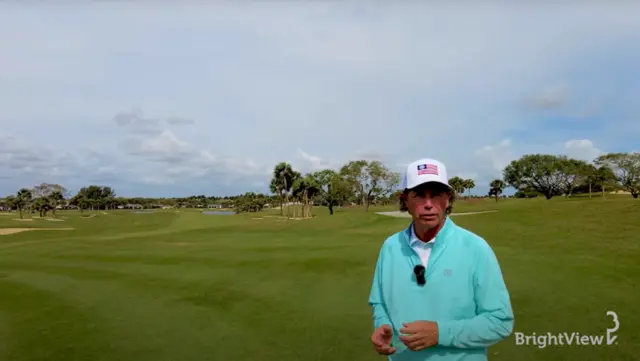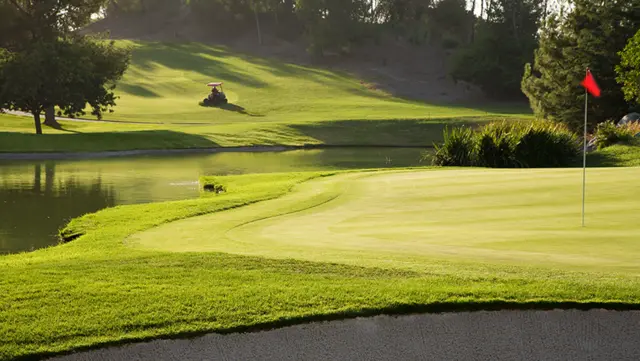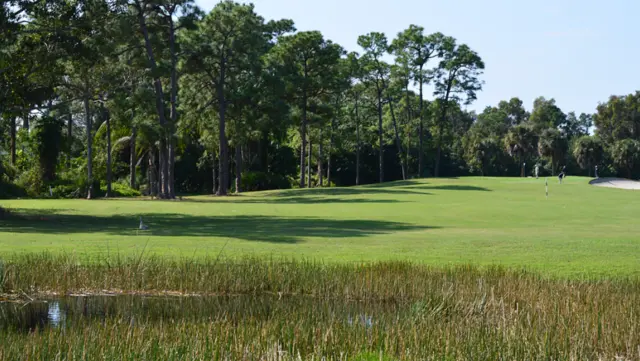
Taming A Golf Course’s 10 Toughest Turf Weeds
Meet the top ten most tenacious weeds on golf courses throughout the United States.
They invade your turf like a scourge, ruining not only the view but also the playing experience for your members and guests. We’ve written before on ways to control weeds, but what if despite your best efforts these unwelcome guests take up residence?
Not to worry. If any of these offenders make an appearance on your golf course, use this guide for effective post-emergent weed control solutions. To make it easier, we’ve separated our golf course maintenance recommendations for warm season turfgrass (Bermudagrass and zoysiagrass), and cool season (ryegrass, Kentucky bluegrass and bentgrass (fairways)). As always, be sure to follow labeled directions with any treatment you use on your turf. Here are our recommendations.
1. Purple and Yellow Nutsedge
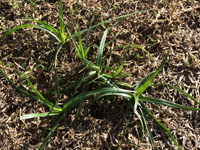
Grass like in appearance, Purple and Yellow Nutsedge have triangular stems, clustered flowers and extensive fibrous roots. You’ll find yellow nutsedge throughout the United States, whereas Purple Nutsedge is typically only found in the southern states and California.
Considered one of the most invasive weeds, nutsedge can proliferate quickly due to tubers or small “nuts” that fall to the ground and lie dormant in the soil for extended periods. One plant can produce thousands of sedge-producing tubers, which is exactly why you want to identify and eradicate these weeds quickly.
Unfortunately, pre-emergence herbicides cannot provide consistent weed control. The key is early and repeated post-emergent treatments.
Post-Emergent Weed Control Treatments for Nutsedge:
- For warm season turfgrass, Certainty, Sedgehammer, Celero, or Monument herbicides are effective. For resistance management and improved control, mix the aforementioned herbicides with Dismiss and/or Basagran T/O herbicides.
- For cool season turfgrass, Sedgehammer, Dismiss, or Basagran T/O works well.
2. Goosegrass
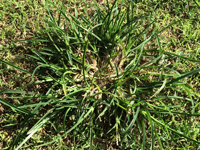
Goosegrass goes by many names—wiregrass, stickyweed, Velcro weed, grip grass and silver crabgrass because of its silvery white color at the base of the plant. We’d like to add the name “Rasputin grass” to the list as this pesky weed grows above the cutting height and can lie down as mowers pass over, simply springing up again once the mower has passed. Prevalent throughout the U.S., goosegrass re-seeds with the wind so eradicating it is tough.
Removal requires prompt attention and careful planning. The modes of attack include hand-weeding (not always practical for widespread invasion) and post-emergent treatments, the most effective of which are noted below.
Post-Emergent Weed Control Treatments for Goosegrass:
- For warm season turfgrass, options include spot applications of MSMA plus Sencor, Revolver plus Dismiss, or Sencor plus Dismiss. Pylex is very effective, but low rates must be used to reduce whitening on bermudagrass. All can be repeated as needed.
- For cool season turfgrass, Pylex will turn goosegrass white and is the best option. Acclaim herbicide can be effective on young goosegrass plants. Multiple applications of SpeedZone Red can also be effective on goosegrass.
3. Crabgrass

Crabgrass, a late summer annual, thrives in full sunlight and warm weather. With a tremendous amount of seed that lies dormant in the soil, crabgrass guarantees repeat performances in your turf. As agronomists say, “One year’s seeding makes seven years weeding,” making it abundantly clear why you should take action immediately once crabgrass invades your turf.
Post-Emergent Weed Control Treatments for Crabgrass:
- For warm season turfgrass, spot applications of MSMA (not available in Florida) or Drive.
- For cool season turfgrass, Drive, Pylex or Acclaim Extra.
4. Dallisgrass
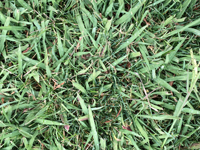
This coarse, densely matted weed produces an unsightly clump in golf courses, making it as unattractive as it is annoying and potentially hazardous. Dallisgrass is drought and frost resistant and can be found throughout the U.S. The weed spreads easily, germinating in spring and summer and growing quickly as summer weather warms. Some dallisgrass patches can be a foot or more in diameter and like crabgrass, it can withstand mowing.
Spot applications prove the most effective for treating dallisgrass and repeated applications are necessary if you want to rid your golf course of this pesky weed.
Post-Emergent Weed Control Treatments for Dallisgrass:
- For warm season turfgrass, Tribute Total or spot applications of MSMA plus Sencor or Dismiss. Plan on three to four applications. (In Florida, where MSMA is not available, spot treat with Tribute Total in the fall.)
- For cool season turfgrass, spot applications of MSMA (if available) plus Dismiss or Pylex. Multiple applications required.
5. Tropical Signalgrass
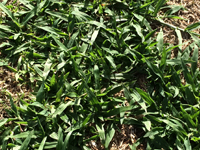
Tropical Signalgrass gets its name from the way in which the leaf angles, much like a signal flag. Signalgrass is a warm season, perennial grass found predominately in coastal South Carolina to Texas and in all of Florida, where MSMA, a highly effective treatment, is banned. Fortunately, there are other ways to battle this weed, and as with all post-emergent treatments, careful timing and multiple applications are required.
Post-Emergent Weed Control Treatments for Tropical Signalgrass:
- Signalgrass dies in the frost so you won’t find it in cooler climates. With that in mind, for warm weather turf, we recommend using MSMA (if available) plus Sencor for two to three applications. In Florida, spot treat with Manuscript for two to three applications.
6. Torpedograss
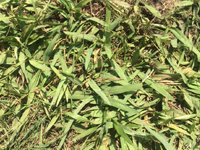
Aptly named, torpedograss is armed with hard, sharp points on its rhizomes, which run underground and punch through weed barriers and landscape fabric with fierce determination. Underground rhizomes of torpedograss have been found up to 6 feet deep in soils, so it is a tenacious weed and very tough to control completely.
This creeping, dense perennial is found mainly in Florida and the Gulf Coast States, often along pond perimeters. Diligent, repeated and frequent efforts are required to control this invasive weed. It’s best to treat this weed as early as possible once you’ve spotted it in your turf.
Post-Emergent Weed Control Treatment for Torpedograss:
- For warm season turf, apply Drive and repeat every three to four weeks or when re-growth occurs.
7. Doveweed
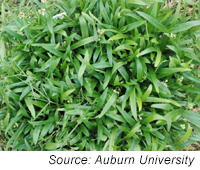
Doveweed may sound harmless but once this weedy plant has made its way into your turf, it can be difficult to remove. Doveweed is a late summer annual and you’ll recognize it by its blue to purple flowers and narrow, lance-shaped leaves growing in alternate patterns. It’s prevalent in the southeastern United States and prefers moist areas, which is why it likes to take up residence in golf course turf.
Post-Emergent Weed Control Treatments for Doveweed:
- For warm season turfgrass, use repeat applications of three-way based products such as Speedzone or Trimec. A new herbicide, GameOn is also very effective.
- For cool season turfgrass, again, use repeat applications of three-way based products such as Speedzone or Trimec. A new herbicide, GameOn is also very effective.
8. Kyllinga Species
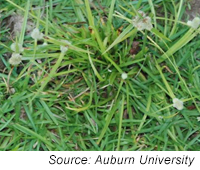
Like other members of the sedge family, kyllinga can take up uninvited residence in turf for years on end. Commonly called spikesedge, kyllinga encompasses both annual and perennial species. You can easily identify it by its sweet smell of mown or crushed leaves—but don’t be fooled, there’s nothing sweet about this weed.
Kyllinga forms large, dense mats and spreads quickly, making it difficult to control. It thrives in areas that are frequently wet and like so many of the top ten, it survives mowing. You’ll find kyllinga throughout the United States and if you find it in your golf course, waste no time in treating it.
Post-Emergent Weed Control Treatments for Kyllinga:
- For warm season turfgrass, use repeat applications of Certainty, Celero and Monument. It is best to mix these herbicides with Basagran T/O or Dismiss to improve control and reduce resistance potential.
- For cool season turfgrass, again, Celero and Dismiss are the best options and can be tank mixed together for best results.
9. Path Rush (Slender Rush)
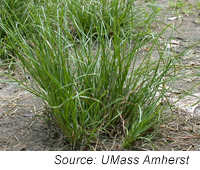
This slender grassy weed goes by several names—path rush, slender rush, poverty rush, field rush and wire grass. By any name, it’s a bear to get rid of. A perennial tufted rush with an extensive root system, this weed is found throughout the United States. It thrives in moist, compacted soil and shaded areas.
Post-Emergent Weed Control Treatments for Path Rush:
- For warm and cool season turfgrass, repeat applications of three-way-based products such as Trimec or Speedzone.
10. Virginia Buttonweed
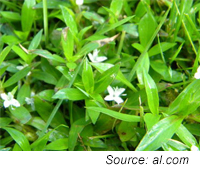
Last but definitely not least on our top ten toughest weeds is Virginia Buttonweed. This mat-forming perennial has small white flowers and is found in the Mid-Atlantic through Gulf Coast States and Florida. Buttonweed easily spreads above and below ground, re-generating itself through seeding, extensive root nodes or even re-planting itself from cuttings thrown out by mowers. Sooner rather than later is the tact to take when ridding your turf of Virginia Buttonweed.
Post-Emergent Weed Control Treatments for Virginia Buttonweed:
- For warm/cool season turf, repeat applications of 2,4-D plus a PPO herbicide (Dismiss, Quicksilver, Octane).
- For warm season turf, repeat applications of Manor + 2,4-D are effective. Repeat applications of 2,4-D plus a PPO herbicide (Dismiss, Quicksilver, Octane) can also be applied to warm season turf.
Word to the Wise: Follow Instructions and Disclaimer
The herbicides listed above are suggestions based upon herbicide efficacy on BrightView Golf Management properties and not golf course maintenance endorsements of the products listed. As with any treatment, herbicide labels should be read carefully with attention paid to turfgrass tolerance and use/site restrictions. Many golf course maintenance products are restricted for use on putting greens and other low-cut areas, so be mindful when using these products. With any new herbicide, small trials should be performed prior to wide scale use to evaluate efficacy and turfgrass tolerance.
Outstanding Golf Course Maintenance
You set the standard, we make it happen. We’re laser-focused on continuously refining the science, technology, and operations of golf course maintenance so we can bring our clients a competitive advantage and a course their players are proud of.

